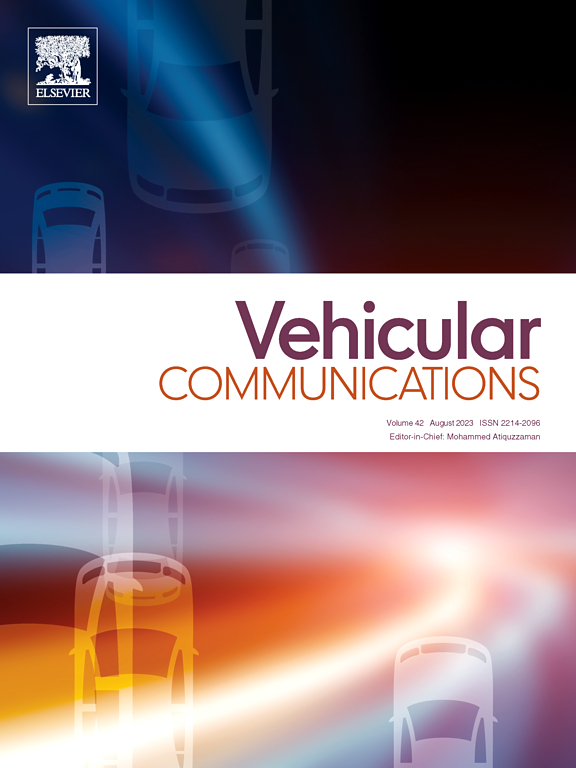Optimal coordinated platoon lane change in highways with mixed traffic
IF 6.5
2区 计算机科学
Q1 TELECOMMUNICATIONS
引用次数: 0
Abstract
In the field of connected autonomous vehicles, platoons - where vehicles closely follow one another - have shown promising results in enhancing safety, traffic flow, and fuel efficiency. This study addresses the unique challenges of platoon lane changes, where multiple platoon vehicles have lane change intention and must remain together after the maneuver is completed. We focus on highway environments because many studies have highlighted the advantages of platooning in these settings. We leverage an offline controller synthesis approach to deal with the combinatorial problem of choosing a strategy. Building on concepts from symbolic optimal control, we represent the problem using a weighted directed acyclic graph where nodes are quantized state vectors, edge weights are costs to transition between nodes, and the shortest path solutions represent the optimal platoon lane change strategies. We use a Cached Branch-and-Bound Depth-First Search algorithm to solve the offline control problem due to its anytime capability and low memory requirements. This approach provides real-time decision making and guarantees maneuver success while minimizing completion time or control effort. Previous works either required control of all vehicles on the road, making them inadequate for mixed-traffic scenarios, or fixed the order in which platoon vehicles change lanes, disregarding the current state of surrounding vehicles and maneuver costs. Our framework can describe all previously proposed methods, relies only on cooperation between platoon vehicles, allows for optimization, and produces solutions whose costs decrease as the allowed computational time increases. We employ the VISSIM traffic simulator to compare our approach to the state of the art. The experiments show that we obtain an increase of 13% in the maneuver completion rate along with a decrease of around 15% to 20% in the maneuver completion time and distance traveled to complete the lane change at the cost of an average increase of 2% to 17% in the longitudinal control effort. This trade-off is a direct consequence of having the platoon occupy suitable lane-changing spaces as soon as possible, and this myopic behavior is necessary when there is no information about the future movements of human-driven vehicles. Moreover, the experiments indicate that our approach yields a sharp decrease in cost in relatively short computational times. These results emphasize the potential for deployment of the proposed method in mixed-traffic highway scenarios.
混合交通高速公路最优协调排变道
在互联自动驾驶汽车领域,车辆紧密跟随的车队在提高安全性、交通流量和燃油效率方面取得了可喜的成果。该研究解决了排变道的独特挑战,其中多个排车辆具有变道意图,并且在机动完成后必须保持在一起。我们之所以关注高速公路环境,是因为许多研究都强调了在这些环境中队列行驶的优势。我们利用离线控制器综合方法来处理选择策略的组合问题。基于符号最优控制的概念,我们使用加权有向无环图来表示问题,其中节点是量化的状态向量,边缘权重是节点之间转换的代价,最短路径解表示最优排变道策略。我们使用缓存分支绑定深度优先搜索算法来解决离线控制问题,因为它具有随时随地的能力和低内存需求。这种方法提供了实时决策,保证了操作的成功,同时最大限度地减少了完井时间或控制工作量。以前的工作要么需要控制道路上的所有车辆,这使得它们不适合混合交通场景,要么固定队列车辆变道的顺序,而不考虑周围车辆的当前状态和机动成本。我们的框架可以描述所有以前提出的方法,只依赖于车队之间的合作,允许优化,并产生成本随着允许的计算时间的增加而降低的解决方案。我们使用VISSIM流量模拟器将我们的方法与最先进的方法进行比较。实验表明,机动完成率提高了13%,机动完成时间和完成变道所需距离减少了约15%至20%,而纵向控制努力平均增加了2%至17%。这种权衡是让车队尽快占据合适的变道空间的直接结果,当没有关于人类驾驶车辆未来运动的信息时,这种短视行为是必要的。此外,实验表明,我们的方法在相对较短的计算时间内产生了成本的急剧下降。这些结果强调了在混合交通高速公路场景中部署所提出方法的潜力。
本文章由计算机程序翻译,如有差异,请以英文原文为准。
求助全文
约1分钟内获得全文
求助全文
来源期刊

Vehicular Communications
Engineering-Electrical and Electronic Engineering
CiteScore
12.70
自引率
10.40%
发文量
88
审稿时长
62 days
期刊介绍:
Vehicular communications is a growing area of communications between vehicles and including roadside communication infrastructure. Advances in wireless communications are making possible sharing of information through real time communications between vehicles and infrastructure. This has led to applications to increase safety of vehicles and communication between passengers and the Internet. Standardization efforts on vehicular communication are also underway to make vehicular transportation safer, greener and easier.
The aim of the journal is to publish high quality peer–reviewed papers in the area of vehicular communications. The scope encompasses all types of communications involving vehicles, including vehicle–to–vehicle and vehicle–to–infrastructure. The scope includes (but not limited to) the following topics related to vehicular communications:
Vehicle to vehicle and vehicle to infrastructure communications
Channel modelling, modulating and coding
Congestion Control and scalability issues
Protocol design, testing and verification
Routing in vehicular networks
Security issues and countermeasures
Deployment and field testing
Reducing energy consumption and enhancing safety of vehicles
Wireless in–car networks
Data collection and dissemination methods
Mobility and handover issues
Safety and driver assistance applications
UAV
Underwater communications
Autonomous cooperative driving
Social networks
Internet of vehicles
Standardization of protocols.
 求助内容:
求助内容: 应助结果提醒方式:
应助结果提醒方式:


